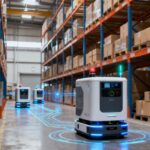Energy crisis has driven the prices of electricity and other energy sources to the highest levels in a century. The operational costs of data center enterprises are rising, making reducing power consumption and increasing sustainability clear business imperatives.With the increase in energy costs and a surge in data consumption, “power consumption” and “sustainability” have become hot topics at this year’s World Mobile Congress. Like the Information and Communication Technology (ICT) industry, the electronic product supply chain is crucial for implementing circular economy technologies and infrastructure.
Currently, the ICT industry consumes about 7% of the world’s electricity. Many indicators suggest that data traffic will continue to grow exponentially. Due to the global supply chain, including manufacturing, infrastructure, and logistics, heavily relying on electricity and fossil fuels, it is expected that by 2040, the carbon emissions from the ICT industry will account for 14% of global emissions.
A report by EY last year revealed a significant increase in data center demand. The COVID-19 pandemic has fueled more data transfer requirements, and data centers are energy-intensive businesses, estimated to consume about 200 TWh of electricity annually, exceeding the national electricity consumption of Iran. Additionally, emerging technologies have high power demands, with Bitcoin alone generating 36.9 megatons of carbon dioxide annually, equivalent to the annual carbon emissions of New Zealand.
The report also points out that training artificial intelligence (AI) models for natural language processing (NLP) results in carbon dioxide emissions equivalent to five times the lifetime emissions of an average U.S. car or the carbon emissions from 300 round-trip flights between San Francisco and New York. By 2030, 5G technology is expected to increase carbon dioxide equivalent emissions by 270-670 million tons annually.
Now, the energy crisis has driven the prices of electricity and other energy sources to the highest levels in a century. The operational costs of data center enterprises are rising, making reducing power consumption and increasing sustainability clear business imperatives.
Arm-based Cloud Servers Face Intense Competition between Intel and AMD
A few years ago, some major cloud providers and other hyperscale providers began replacing x86-based servers with Arm-based servers. The Arm architecture, based on the RISC instruction set, is ubiquitous in mobile devices, offering significant power savings and, in many cases, improved performance.
Unlike traditional x86 processors, Arm processors are designed with low power consumption in mind, making them an ideal choice for energy-efficient data centers. Arm’s V9 architecture promises a performance improvement of over 30% in the next two generations of mobile and infrastructure. Since the introduction of the V9 architecture, Arm has been researching various technologies to improve CPU performance, such as maximizing frequency, bandwidth, cache, and reducing memory latency. They are introducing several new features dedicated to AI, including increased hardware support for AI in CPU, GPU, and NPU product combinations.
Omdia’s data shows that by the second quarter of 2022, Arm’s market share in data centers had risen to 7.1%, higher than the less than 1% in 2019, 2.2% in 2020, and 5.4% at the end of 2021. Although Arm’s market share in data centers is relatively small, the trend of Arm architecture in data centers is evident and expected to continue.
During the World Mobile Congress from February 27 to March 2, Mohamed Awad, Senior Vice President and General Manager of the Infrastructure Business Unit at Arm, outlined the development of the data center industry and revealed the reasons why Arm became the preferred architecture for new data centers.

Awad believes that Arm has achieved significant success in the data center field because Arm provides something that other architectures may not. “We can provide customized solutions based on Arm’s IP or compute subsystem according to user needs. Now, mainstream hyperscale companies are deploying Arm-based servers,” he added. “Four years ago, the number of 5G connections was less than a million. Now, the number of 5G connections has exceeded a billion. Due to the tenfold bandwidth of 5G terminals compared to 4G terminals, the global data volume has increased from 30 ZB-35 ZB four years ago to over 120 ZB today. In addition, sustainability and energy challenges are becoming increasingly significant. After all, four years ago, there was no war in Europe, and there was no energy crisis globally. Now, ESG (environment, social, and governance) and sustainability are the top considerations for many companies’ development.”
Arm is collaborating with several hyperscale manufacturers to design new processors to increase bandwidth, processing performance, and reduce power consumption. Using AWS and its Graviton processors as an example, Awad stated, “These servers are developed using SoCs based on Arm’s Neoverse platform. Now, they can provide computing instances that cost 30%-40% less than instances based on other architectures. This cost reduction is not only due to lower silicon costs but also related to establishing an overall architecture at the server level and achieving power savings in data centers.”
“In the end, infrastructure is a data problem. It involves not only the infrastructure I just described but also the world’s largest supercomputers and the smallest sensors. It’s about how to capture data on microsensors, process that data most efficiently, move the data to higher-order computing nodes when needed, and do all of this in the best possible way.”
Enterprises Need to Prioritize Power Efficiency as the Top Task for IT
Improving the sustainability of IT infrastructure is more urgent than ever. The rapid growth of data centers and the increasing data collected via wireless networks have led to a substantial increase in energy consumption and greenhouse gas emissions.
As energy costs continue to rise, exacerbating climate change and increasing business costs, promoting sustainability in IT infrastructure is crucial. This includes using more efficient computing systems, adopting renewable energy, and implementing sustainable computing practices.
According to Bloomberg, technology giants such as Apple, Alphabet, Amazon, and Microsoft have committed to decarbonizing their supply chains. However, these giants have not made their supply chain partners accountable for this goal. Nevertheless, these companies’ influence spans across various areas, from chip manufacturing to delivering products to end-users. Auditing and other accountability measures can drive the achievement of global sustainable development goals.













Leave a comment